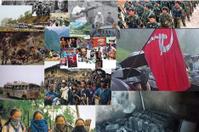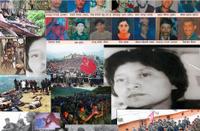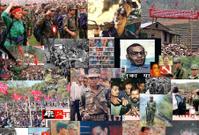
I tried to collect photos online for a collage of the democratic coalition. I am surprised - perhaps I should not be - I can not find a single photo of Hridayesh Tripathy.
Bijay Kumar might be one of the few mainstream journalists in Nepal who has given Tripathy his due. He has featured Tripathy at Dishanirdesh quite regularly.
I tried to capture a still image from the video archives at Dishanirdesh, but so far have not been successful for technical reasons.
But then Bijay Kumar himself has been sidelined by the current regime. His program has been shelved. If the junta ever needed to show its true colors.
I emailed both Hridayesh Tripathy and Rajendra Mahto requesting they email me their digital photos.
My childhood friend Rajesh Gupta, more technologically proficient than me, is also making a go at extracting a still image from the Bijay Kumar archives. Let's see if he can do it.
It's such a shame.
The Sadbhavana has been unique in highlighting the political plight of the Madhesis. Most everyone else does not even seem to have the vocabulary. Not even the Madhesis in the other parties, including the prominent ones.
The new constitution will have to accord the Madhesis political equality at the outset, the cornerstone of which will have to be (1) federalism, (2) all parliamentary constituencies demarcated on near equal population, and (3) due recognition of Hindi as the lingua franca of the Terai.
Enough is enough.
Nothing is more laughable than the remnants of Pahadi chauvinism within the democracy movement. So you want my support for what? It is not democratic unity to keep mum on the Madhesi issue. It is not democratic, for sure, and it sure is not unity. A political system that does not accord political equality to Madhesis is not democracy, it is sham.
Okay, Gupta's efforts too failed. So the collage is sans Tripathy.
- Defending The Sadbhavana
- Defending the Sadbhavana (II)
- Tackling Ethnic Issues In Nepal
- Ethnic Issues (II)
- The Sadbhavana Dilemma (September 7, 2004)
- The Madhesi Identity Outlets (July 2, 2004)
- Federalism For Nepal: The Only Solution (July 1, 2003)
- Part 15: The king is an obstacle to the democrat Bahuns, those Bahuns are an obstacle to the DaMaJaMa.
- Part 16: (Hindi and Maithili) What can the Madhesis do for Madhesi rights?
- Part 17: (Maithili) Madhesi hum lenge sau mein pachas.
- Part 18: (Maithili) The Sadbhavana is a litmust test for the Madhesis who have made it.
Here is a news clip from July 17.
The media’s ethnic gap Nepali Times, Nepal .... an anguished email from a well-known author and editor, a pahadi janajati, citing a small news item which reported that no journalist turned up for a press conference called by madhesi students. He was agitated by this gross discrimination..... The media influences public knowledge and opinion bot
 h by what it reports and what it leaves out...... the grievances of a handful of madhesi university students being beaten up .... one more example of the perhaps unconscious collective effort of the pahadia dominated press to erase madhesis from the media and thus from public knowledge and national discourse .... the press on the whole did not report on the first ever national conference on the tarai, focusing especially on the madhesis...... conference was held in a well-known hotel, press releases were faxed and it was attended by several journalists..... no serious reporting on the discussions of the conference nor even a mention of the dukkha of being a madhesi .... Journalists do write or speak about the madhesh or tarai but mainly as a location down south where negative events occur. The madhesis themselves hardly figure in the stories. Or as one madhesi journalist bitterly complained during a conference, the national press usually ignores madhesis except to portray them in bad light. A reputed organisation which has published a series of landmark books on the media’s coverage of dalits and janajatis has not yet brought out a publication on the media and madhesis....... pahadi media gatekeepers are doing injustice to madhesis ....
h by what it reports and what it leaves out...... the grievances of a handful of madhesi university students being beaten up .... one more example of the perhaps unconscious collective effort of the pahadia dominated press to erase madhesis from the media and thus from public knowledge and national discourse .... the press on the whole did not report on the first ever national conference on the tarai, focusing especially on the madhesis...... conference was held in a well-known hotel, press releases were faxed and it was attended by several journalists..... no serious reporting on the discussions of the conference nor even a mention of the dukkha of being a madhesi .... Journalists do write or speak about the madhesh or tarai but mainly as a location down south where negative events occur. The madhesis themselves hardly figure in the stories. Or as one madhesi journalist bitterly complained during a conference, the national press usually ignores madhesis except to portray them in bad light. A reputed organisation which has published a series of landmark books on the media’s coverage of dalits and janajatis has not yet brought out a publication on the media and madhesis....... pahadi media gatekeepers are doing injustice to madhesis ....




